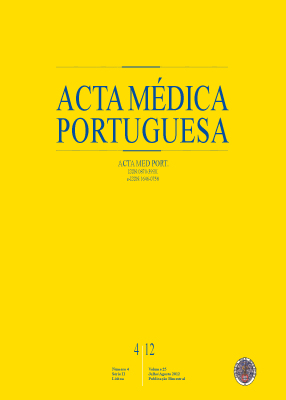Growth and puberty in type 1 diabetes mellitus - experience from a pediatric endocrinology unit
DOI:
https://doi.org/10.20344/amp.63Abstract
Background: Type 1 Diabetes Mellitus (T1DM) is the most common endocrine-metabolic disease in children. It is associated with vascular and neuropathic complications, and may also affect growth and development.
Objective: To correlate the metabolic control and disease duration with growth and puberty in patients with T1DM followed in a Pediatric Endocrinology Outpatient Clinic.
Subjects and methods: Retrospective analysis. Sample obtained from patients with T1DM followed in Hospital Santa Maria Pediatric Endocrinology Outpatient Clinic (Lisbon – Portugal) since 1994 until March 2011. Inclusion criteria: patients diagnosed before the onset of puberty and who had attained their final height during the follow-up. Variables: sex, age, weight and height at diagnosis and final, parents’ height, growth velocity, pubertal height gain, age at menarche and metabolic control during puberty.
Results: 39 patients, 51% female, 82% diagnosed less than five years before puberty. Fifty-four percent presented an average HbA1c between 8-10%, what we considered reasonable. There seems to be a trend towards an inverse association between HbA1c and the maximum speed of growth and pubertal height gain, although not statistically significant. These patients were taller than average at diagnosis (z-score: male 0.9; female: 0.5) and lost height during puberty, yet attained final heights within normal range and matching their target heights.
Conclusions: Although HbA1c seems to negatively influence maximum growth rate and pubertal height gain, there was no compromise in final height in this group of patients.
Downloads
Downloads
Published
How to Cite
Issue
Section
License
All the articles published in the AMP are open access and comply with the requirements of funding agencies or academic institutions. The AMP is governed by the terms of the Creative Commons ‘Attribution – Non-Commercial Use - (CC-BY-NC)’ license, regarding the use by third parties.
It is the author’s responsibility to obtain approval for the reproduction of figures, tables, etc. from other publications.
Upon acceptance of an article for publication, the authors will be asked to complete the ICMJE “Copyright Liability and Copyright Sharing Statement “(http://www.actamedicaportuguesa.com/info/AMP-NormasPublicacao.pdf) and the “Declaration of Potential Conflicts of Interest” (http:// www.icmje.org/conflicts-of-interest). An e-mail will be sent to the corresponding author to acknowledge receipt of the manuscript.
After publication, the authors are authorised to make their articles available in repositories of their institutions of origin, as long as they always mention where they were published and according to the Creative Commons license.









